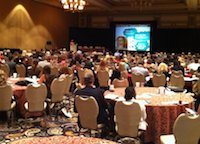Presentations. Speeches. Talks.
Presentations. Speeches. Talks.
Everyone does them. Most people dread giving them. But only a few presenters know the magic behind delivering an exceptional, memorable and impactful public presentation.
From a Kiwanis Club luncheon to a staff lecture…from a major medical society presentation to a foundation or charity fundraising pitch, everyone gets the call. And it seems that doctors, marketing executives and hospital administrators are frequently invited to present, persuade and/or convince audiences from six to 600.
You need only to see or recall a TED Talk to know how excellent presentations can be. The nonprofit TED organization is devoted to spreading ideas via short, powerful talks (18 minutes or less) about topics from science to business to global issues.
As a practical matter, clear and confidant speaking skills are assets that leaders and managers can use daily. What’s more, they reflect positively on your personal image and professional reputation.
Over the years, we have yet to see a TED Talk, regardless of the topic or the speaker, which did not seem nearly effortless and immediately engaging. But, as all of us who have stepped up to the platform know, there are trade secrets to successful public speaking.
Here are some of the most important ways to prepare and present like a pro:
1. Master the fundamentals. This isn’t much of a secret, but there’s no way to skip being proficient with the basics such as “know your material,” “practice,” and “know the audience.” Toastmasters International provides a solid list of essentials in their 10 Tips for Public Speaking. And, in more detail, see Public Speaking: The Basics from the University of Pittsburgh.
2. Channel anxiety into confident energy. No doubt you know that “fear of public speaking” (Glossophobia) is nearly universal. Studies say that at least three out of four people experience some degree of nervousness when speaking, (and the fourth person might be fibbing). “Presentation anxiety” is common among experienced stage and screen performers, musicians, competitive athletes and many others.
You wouldn’t know it to watch them, but a secret of many top speakers is to embrace their anxiety and channel it into personal passion for their subject and their presentation. Sports champions “get pumped” before the game. It takes practice and discipline, but the genuine energy of top speakers is audience-contagious.
3. Have one, and only one, big idea. Anyone who is an expert, and knows a ton of things about their topic, faces the temptation to present too much information (TMI). An expert presentation will focus on a single core concept. Speakers find and deliver that one highly compelling idea that benefits the audience, they get to the point quickly and they support the main point without tangents or TMI overload.
4. You are the messenger, not the message. The best presentations are about the audience and not about the speaker. The audience may have been attracted by the speaker’s name or reputation, and they enjoy the means and methods of the communicator. But what the audience expects and appreciates most from a great presentation is their “takeaway.” Make the speech about them, with the primary payoff of gifting the audience with a useful idea, provocative concept, special insight or personal emotional lift.
5. Engage the mind through the heart. A SlideShare deck or Excel Spreadsheet will never win an Academy Award. The first order of business for exceptional public speakers is to emotionally engage the audience and connect with them as individuals. Top presenters identify what’s significant to the listener’s value system and touch their emotions through well-told stories, humor or illustrations. The fast track to audience engagement, and their rapid investment in your presentation, begins with a strong emotional touch.
MORE TRADE SECRETS OF TOP SPEAKERS are presented in our second and concluding article in this series.

